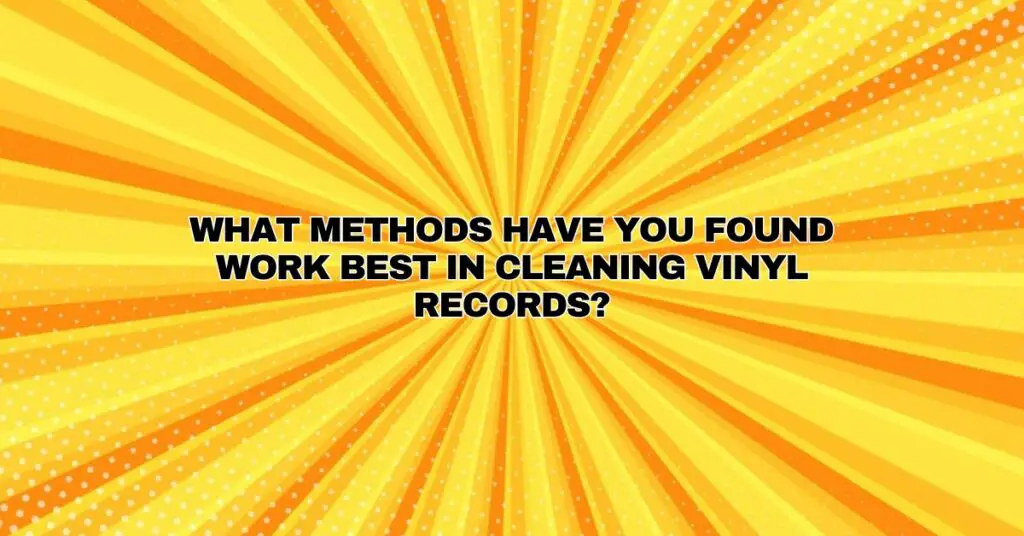Vinyl records, with their unique analog warmth and immersive sound, have experienced a remarkable resurgence in popularity. Whether you’re an avid collector or a casual listener, the quest for clean and pristine records is essential to ensure an optimal listening experience. In this comprehensive article, we will explore the most effective methods for cleaning vinyl records, from simple brushing and manual cleaning to advanced techniques and professional-grade record cleaning machines. By understanding and applying these methods, you can maintain your vinyl collection in top-notch condition, ensuring that your records deliver the rich, warm sound that vinyl enthusiasts cherish.
1. The Importance of Record Cleaning
Cleaning vinyl records serves several crucial purposes:
- Dust and Debris Removal: Records accumulate dust, dirt, and microscopic particles that can lead to surface noise and affect sound quality.
- Static Reduction: Reducing static electricity helps prevent dust and debris from clinging to the record surface.
- Surface Cleaning: Removing fingerprints, oils, and smudges ensures a smooth and uninterrupted stylus glide.
2. Manual Cleaning Methods
Manual cleaning methods are accessible and effective for routine vinyl record maintenance:
- Carbon Fiber Brushes: Carbon fiber brushes are anti-static and feature fine bristles that sweep away dust and debris when gently rotated on the record surface.
- Anti-Static Brushes: These brushes reduce static charge, making it easier to remove dust and preventing its rapid return.
- Velvet Brushes: Velvet brushes are gentle and effective at removing surface dust and contaminants, although they may not have anti-static properties.
- Goat Hair Brushes: Goat hair brushes are very soft and suitable for removing surface dust. They may lack anti-static properties but are gentle on records.
3. Manual Wet Cleaning
For deeper cleaning, manual wet cleaning methods can be employed:
- Microfiber Cloth: Dampen a microfiber cloth with a record cleaning solution and gently wipe the record’s surface, following the grooves. Use a dry cloth to remove any remaining moisture.
- Record Cleaning Solution: A specialized record cleaning solution, when applied with a soft brush or cloth, effectively removes dirt and contaminants.
4. Advanced Cleaning Methods
Advanced cleaning methods are suitable for records in need of deeper cleaning:
- Record Cleaning Machines: Professional-grade record cleaning machines use a combination of cleaning solution and vacuum suction to deep-clean records without leaving residue. These machines are efficient but may be costly.
- Ultrasonic Cleaning: Ultrasonic record cleaning machines use high-frequency sound waves to agitate the cleaning solution, effectively removing dirt and contaminants from the grooves. This method is highly effective but can be expensive.
5. Tips for Effective Record Cleaning
Regardless of the method you choose, here are some tips for effective record cleaning:
- Clean Hands: Always handle records with clean hands to prevent oils and dirt from transferring to the surface.
- Proper Storage: Store records vertically in a stable, climate-controlled environment to minimize exposure to dust and humidity.
- Routine Maintenance: Incorporate regular cleaning into your record-playing routine to prevent dirt buildup.
6. Conclusion
Cleaning vinyl records is a fundamental aspect of vinyl maintenance, ensuring that records remain in optimal condition and deliver a high-quality listening experience. The choice of cleaning method depends on the level of cleaning required, your budget, and your commitment to record maintenance. Whether you opt for simple brushing and manual cleaning or invest in advanced cleaning equipment, the goal is the same: to enjoy your vinyl collection with the rich, warm sound that makes vinyl a cherished medium for music enthusiasts worldwide.


